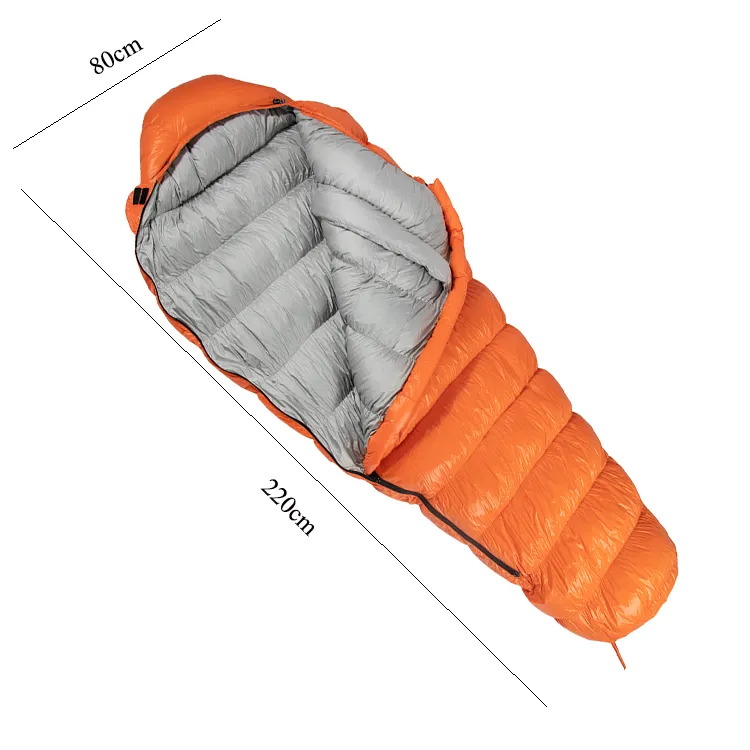
Kvě . 23, 2025 10:04 Zpět na seznam
Maximizing Space with an XL Down Sleeping Bag
When packing for outdoor adventures, an XL down sleeping bag offers unparalleled comfort for taller individuals or those who prefer extra room. However, its larger size can pose challenges for efficient storage. The key lies in compression techniques that maintain the bag’s loft while minimizing bulk. Start by gently shaking the duck down sleeping bag to evenly distribute the insulation. Avoid over-compression, as this can damage the delicate down clusters and reduce thermal efficiency over time. Instead, use a high-quality compression sack designed for duck sleeping bag models, which allows gradual pressure adjustment.

For those prioritizing space-saving solutions during a duck down sleeping bag sale, consider investing in a vacuum compression bag. These tools remove excess air without crushing the down, making the XL down sleeping bag compact enough to fit into tight backpack compartments. Always ensure the sleeping bag is completely dry before compression, as moisture trapped in down insulation can lead to mold growth and odor. By mastering these methods, adventurers can enjoy the warmth of a spacious duck down sleeping bag without sacrificing precious pack space.
Protecting Your Duck Down Sleeping Bag from Moisture
Moisture is the arch-nemesis of any duck down sleeping bag, as dampness clumps the down and nullifies its insulating properties. To safeguard your gear, begin by storing the bag in a breathable storage sack when not in use—never leave it compressed in its stuff sack. For added protection during trips, line your backpack with a waterproof liner and place the duck sleeping bag at the bottom, away from potential leaks. Silica gel packets or moisture-absorbing sheets can be tucked nearby to combat ambient humidity.
In wet conditions, a waterproof stuff sack is non-negotiable for XL down sleeping bag users. Look for sacks with welded seams and roll-top closures to create an impenetrable barrier against rain or accidental water exposure. If your duck down sleeping bag does get damp, air it out immediately upon reaching camp. Hang it loosely in a shaded, ventilated area, avoiding direct sunlight that could degrade the nylon or polyester shell fabric. For long-term storage after a duck down sleeping bag sale, choose a cool, dry location away from attics or basements where temperature fluctuations are common.
Organizational Hacks for Duck Sleeping Bag Accessibility
Efficient packing transforms a duck sleeping bag from bulky necessity to strategic asset in your survival kit. Utilize your backpack’s vertical space by placing the XL down sleeping bag vertically along the back panel, creating a stable base for heavier items. For multi-day hikes, pair the sleeping bag with a modular packing system: store clothing layers inside its compression sack to create a makeshift pillow. This approach not only saves space but also ensures quick access to essentials.
Color-coding gear can streamline retrieval during low-light conditions. Opt for a brightly colored stuff sack for your duck down sleeping bag, making it instantly recognizable among darker equipment. Additionally, attach a small carabiner to the sack’s loop, allowing it to clip onto external backpack straps for rapid deployment. These tactics are particularly valuable during duck down sleeping bag sales, where buyers might acquire multiple sizes for different seasons—staying organized prevents mix-ups during critical moments.
Enhancing Durability in Duck Down Sleeping Bag Designs
Modern duck down sleeping bag models prioritize durability through advanced fabric technologies. The 220x80x50cm dimensions of our XL down sleeping bag are crafted from ripstop nylon or polyester blends, materials chosen for their tear resistance and lightweight properties. These fabrics withstand abrasion from rough terrain while maintaining breathability—a crucial feature for preventing condensation buildup during extended use.
Reinforced stitching along stress points, such as zipper seams and baffle edges, ensures the duck sleeping bag retains its structural integrity through countless compressions. The inclusion of YKK zippers with anti-snag designs further enhances reliability. For buyers participating in a duck down sleeping bag sale, these construction details translate to long-term cost savings, as reduced wear minimizes the need for premature replacements.
FAQs: How to Store and Carry a Down Sleeping Bag
Can I machine wash my duck down sleeping bag?
Yes, but use a front-loading machine on gentle cycle with down-specific detergent. Avoid agitators that could tear internal baffles.
How do I restore loft in an old XL down sleeping bag?
Tumble dry on low heat with tennis balls to break up clumped down. Repeat until fully fluffy.
Is a duck sleeping bag suitable for sub-zero temperatures?
Our 650+ fill power duck down sleeping bags are rated for -10°C (14°F), ideal for most cold-weather camping.
What’s the best way to dry a wet duck down sleeping bag outdoors?
Hang it loosely over a tree branch or tent line, flipping periodically. Prioritize shaded areas to prevent UV damage.
Can I use a regular backpack for an XL down sleeping bag?
Ensure your pack has at least 60L capacity and compression straps to secure the XL down sleeping bag properly.
Don’t compromise on comfort or durability—explore our exclusive duck down sleeping bag sale featuring industry-leading insulation and rugged fabrics. Whether you’re braiding icy peaks or camping under autumn skies, our XL down sleeping bag collection delivers unmatched warmth-to-weight ratios. Visit our website today to claim your adventure-ready sleep system before seasonal stocks vanish!
-
Baggu Picnic Blanket: Waterproof, Sandproof, Extra-Large
ZprávyNov.17,2025
-
Camping Picnic Mat: Waterproof, XL, Foldable, Durable
ZprávyNov.17,2025
-
Foldable Picnic Rug - Waterproof, Lightweight, XL Comfort
ZprávyNov.17,2025
-
Camping Picnic Mat – Waterproof, Extra Large & Portable
ZprávyNov.17,2025
-
Camping Picnic Mat - Waterproof, Extra Large, Portable Rug
ZprávyNov.17,2025
-
Outdoor Rug for Picnic – Waterproof, XL, Foldable with Bag
ZprávyNov.17,2025
